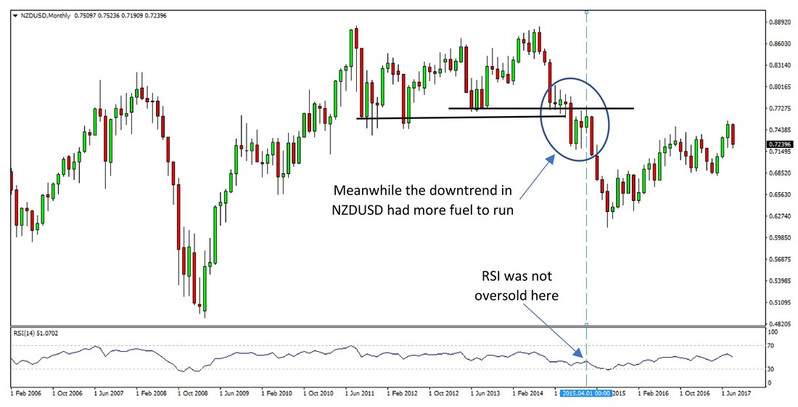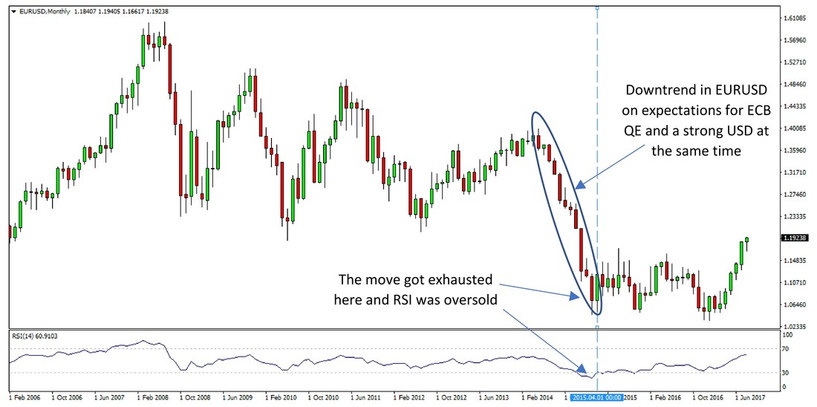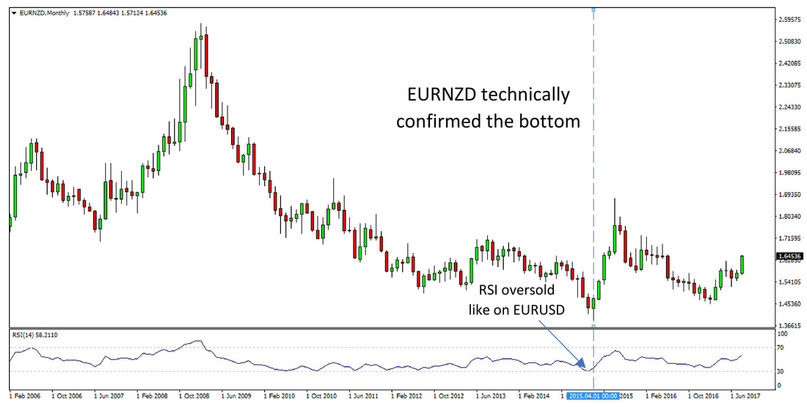Combining Fundamentals with Technicals to Trade the Crosses
As we discussed previously, combining technical analysis from two major pairs to analyze a specific cross in question can be a great way to spot highly profitable opportunities in Forex.
In this article, we continue with more similar examples but we also add the fundamentals in the mix to show the complete picture of why and how some currency pairs moved during a certain period of time.
Combining the two pillars, fundamentals and technicals, is important in determining the overall trends and in efficiently timing the entries to catch the best trends in FX.
Trading only on fundamentals can often lead to prolonged periods of corrections or large moves against the fundamentals and your position.
A currency can stay fundamentally overvalued or undervalued for many months and even years before it finally makes a turn to revert to the mean.
On the other hand, trading only on technicals can lead to missing on tectonic shifts in currency trends and therefore missing excellent trading opportunities and even recording large losses.
In the end, whether a technical level holds or is broken depends on the fundamentals – especially over the longer term.
Let’s now take a look at the bottom in the EURNZD and the subsequent 3000+ pips rebound in the spring and summer of 2015.
The Fundamental Situation in EURNZD 2015 Bottom
The Euro was in a downtrend for the whole year of 2014 and until March 2015 on expectations that the European Central Bank will start a quantitative easing program to fight falling inflation in the Euro Area.
The common currency bottomed out on a broad basis against its peers when the ECB finally began QE bond purchases in March 2015 as the QE program was fully priced in by markets at this point and it was essentially the maximum that the ECB could do in terms of weakening the currency.
A period of prolonged consolidation in the Euro was imminent as the ECB was in a wait and see mode to evaluate how the QE impacted the economy.
Further, this example nicely demonstrates how markets really move on expectations for something to happen rather than when the actual event occurs or is underway.
At about the same time as EURUSD bottomed out, there was more room for NZDUSD to fall from the expensive levels in the 0.7600 area in which it was then trading. The New Zealand economy has just started to lag behind the other advanced economies with unemployment starting to move up and inflation expectations falling.
As a result, the RBNZ began a rate cutting cycle to aid the economy, bringing interest rates down to 1.75% in November 2016 from 3.5% in April 2015. The New Zealand Dollar weakened across the board in the months following the first rate cut from the RBNZ.
However, as is evident from the charts and as is usually the case, markets run ahead of themselves and prices and currency exchange rates often overshoot in one direction.
After sharply falling for 3 straight months, the NZ Dollar then bottomed out in August 2015 (just 2 - 3 months after the first rate cut) while the RBNZ continued to cut rates until November 2016. This is why fundamentals can often be tricky for trading.
To conclude, as the two events occurred almost simultaneously, the ECB long-anticipated start of QE and RBNZ unexpected start of a rate cutting cycle, it was clear that EURNZD should form a bottom as well.
EURNZD Technical Picture
Let’s turn now to the technicals on the monthly charts in the EURUSD and NZDUSD major pairs as well as the EURNZD pair itself.
The specific time we are examining is April 2015 (blue vertical line on all 3 charts) because it was the turning point in EURNZD. As is evident from the charts important shifts are also occurring on both EURUSD and NZDUSD during the same month.
NZDUSD was in a consolidation at that time (February – May 2015) just before the RBNZ began to cut rates after a strong downtrend since mid-2014. In the encircled area and as marked with the vertical dotted line we can see that the pair came back to retest a broken support, touched it in April and then plunged again in May.
The shallow price action after the January plunge and the retest of the broken support combined with a dovish RBNZ suggested NZDUSD path of least resistance is lower.

NZDUSD retests broken support and plunges – Monthly chart
EURUSD, on the other hand, started a bottoming process in April 2015 by forming a bullish engulfing candlestick pattern on the monthly chart. This was at a time when the pair was technically deeply oversold (see RSI on the chart) and fundamentally undervalued according to fundamental valuation metrics such as PPP.
Given this, it was clear that EURUSD cannot weaken much further while room in NZDUSD to take another leg lower (on the monthly chart) meant that EURNZD will bottom as well and even rally strongly on NZD weakness which is what happened exactly.

EURUSD formed a bottom as the fall due to ECB easing was exhausted – Monthly chart
It’s interesting to note that EURNZD was also in a downtrend until April 2015 because of relative Euro weakness as we discussed earlier.
A bullish engulfing candlestick pattern was formed in April 2015 before an even stronger rally in May (coinciding with the fall in NZDUSD after retesting the resistance in April).

EURNZD rebounded powerfully in the same period – Monthly chart
Finally, this example shows how we can use a short-term rebound in one currency pair (EURUSD) to catch a stronger move in a cross pair because of weakness in the other major pair (NZDUSD).
Of course, we should keep in mind that in this specific case the Euro was the weakest major currency in that period (2014 - 2015), while the US Dollar was the strongest. Hence, we couldn’t have counted on a long period of Euro strength at that time and as is evident from the charts both EURUSD and EURNZD drifted down again following the peaks in August 2015.
However, the insight that EURNZD should bottom and maybe bounce is valuable because it can also provide protection against highly volatile US news events that may affect USD pairs. In such cases, we completely bypass the US event by trading a cross as was EURNZD in this example.





